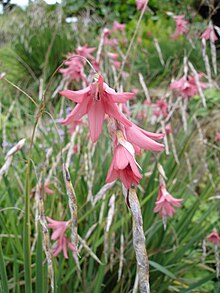Dierama
| Dierama | |
|---|---|
 |
|
| Dierama igneum | |
| Scientific classification | |
| Kingdom: | Plantae |
| (unranked): | Angiosperms |
| (unranked): | Monocots |
| Order: | Asparagales |
| Family: | Iridaceae |
| Subfamily: | Ixioideae |
| Tribe: | Ixieae |
| Genus: |
Dierama K. Koch |
| Type species | |
|
Dierama ensifolium Koch & Bouché |
|
| Species | |
|
See text |
|
See text
Dierama, is a genus of flowering plants in the iris family, Iridaceae. Common names include hairbells, Angel's Fishing Rod, fairybells, and wandflowers in English and grasklokkies in Afrikaans. They are native to Africa, with most occurring in the southern regions of the continent. The center of diversity is the Province of KwaZulu-Natal in eastern South Africa.
Plants of this genus are evergreen perennial herbs growing from large, fibrous-coated corms. The lowest two or three leaves are cataphylls that sheath the lower stem and may soon become dry. The thin, wiry, branching stem may bend and droop when in flower. It is lined with leaves that have linear blades with thick longitudinal veins and often no midrib. The inflorescence is a panicle of several spikes of flowers. The spikes may hang like bells or grow erect. The bracts around the flowers are usually dry, thin, membranous, translucent, and streaked or veined with brown. The bell-shaped flowers of most wild species are pink, and there are also red, purple, yellow, and white taxa. There are many cultivars in a range of colors, sometimes with spots of yellow or blue. The fruit is a spherical capsule.
The genus name is derived from the Greek word dierama, meaning "funnel", and alludes to the shape of the flower.
There are about 44 species.
Species include:
Some dieramas are cultivated as ornamental plants, such as the purple-pink-flowered D. pendulum. The South African endemic D. erectum is grown for the large, pink flowers it bears on tall, erect stems. It is prone to attack by the bean weevil Urodon lilii.
...
Wikipedia
